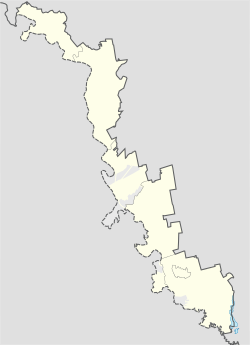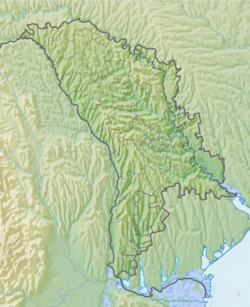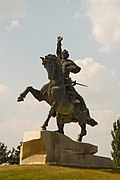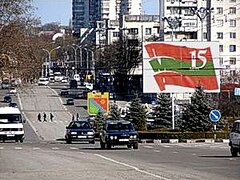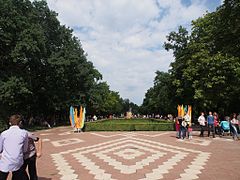Tiraspol
You can help expand this article with text translated from the corresponding article in Russian. (February 2017) Click [show] for important translation instructions.
|
This article needs additional citations for verification. (September 2022) |
Tiraspol
Тирасполь · Тираспол | |
|---|---|
City Hall, Church of the Nativity, Drama theater, Stalinist Palace of Culture, Supreme Council of Transnistria, city trolleybus, Suvorov Square | |
| Anthem: "Be glorious, our city!" | |
| Coordinates: 46°50′25″N 29°38′36″E / 46.84028°N 29.64333°E | |
| Country (de jure) | |
| Country (de facto) | |
| Founded | 1792 |
| City rights | 1795[2] |
| Government | |
| • Head of the State Administration of Tiraspol | Oleg Dovgopol[3] |
| Area | |
• Total | 55.56 km2 (21.45 sq mi) |
| Elevation | 26 m (85 ft) |
| Population (2018) | |
• Total | 128,600[1] |
| Area code | + 373 533 |
| Website | tirasadmin |
Tiraspol (Russian: Тирасполь, pronounced [tʲɪˈraspəlʲ]; Romanian: Tiraspol, [tɪˈrɑspol], Moldovan Cyrillic: Тираспол, also Tirișpolea;[4][5] Ukrainian: Тирасполь, romanized: Tyraspol') is the capital and largest city of Transnistria, a breakaway state of Moldova, where it is the third-largest city. The city is located on the eastern bank of the Dniester River. Tiraspol is a regional hub of culture, economy, tourism, and light industry, such as furniture and electrical goods production.
The modern city of Tiraspol was founded by the Russian generalissimo Alexander Suvorov in 1792, although the area had been inhabited for thousands of years by varying ethnic groups.[6] The city celebrates its anniversary every year on 14 October.[7]
Etymology
[edit]The toponym consists of two ancient Greek words: Τύρας, Tyras, the Ancient name for the Dniester River, and polis, i.e., a city (state).[8]
History
[edit]
Republic of Moldova 1991–present (de jure)
Transnistria 1990–present (de facto)
USSR 1944–1991
Kingdom of Romania 1941–1944
USSR 1922–1941
Ukrainian SSR 1921–1922
Ukrainian People's Republic 1917-1919
Russian Republic 1917
Russian Empire 1792–1917
Classical and medieval history
[edit]Tyras (Τύρας), also spelled Tiras, was a colony of the Greek city Miletus, probably founded about 600 BC, situated some 10 kilometres (6 miles) from the mouth of the Tiras River (Dniester). Of no great importance in early times, in the second century BC it fell under the dominion of indigenous kings whose names appear on its coins. It was destroyed by the Thracian Getae about 50 BC.[citation needed]
In 56 AD, the Romans restored the city and made it part of the colonial province of Lower Moesia.[citation needed] A series of its coins exist that feature heads of Roman emperors from Domitian to Severus Alexander. Soon after the time of the latter, the city was destroyed again, this time by the invasion of the Goths. Its government was in the hands of five archons, a senate, a popular assembly, and a registrar. The images on its coins from this period suggest a trade in wheat, wine, and fish. The few inscriptions extant are mostly concerned with trade.[citation needed]
Such ancient archeological remains are scanty, as the city site was built over by the great medieval fortress of Monocastro or Akkerman.[9] In the Late Middle Ages, the area around of modern Tiraspol became part of the Grand Duchy of Lithuania. The Lithuanians, unable to settle their vast state on their own, allowed Moldavian settlement in the area.[10]
Tsarist Russian rule
[edit]This section needs additional citations for verification. (January 2024) |
The Russian Empire conquered its way to the Dniester River, taking territory from the Ottoman Empire. In 1792 the Russian army built fortifications to guard the western border near a Moldavian village named Sucleia. Field Marshal Alexander Suvorov is considered the founder of modern Tiraspol; his statue is the city's most distinctive landmark.[11] The city took its name from Tyras, the Greek name of the Dniester River on which it stands. It was granted city rights in 1795.[2]
In 1828, the Russian government established a customs house in Tiraspol to try to suppress smuggling. The customs house was subordinated to the chief of the Odesa customs region. It began operations with 14 employees. They inspected shipments of bread, paper, oil, wine, sugar, fruits and other goods.

In December 1917, Tiraspol hosted a congress of Transnistrian Moldovans, at which they wished to unite the city with Bessarabia.[12]
Soviet Tiraspol
[edit]
After the Russian Revolution, the Moldavian Autonomous Soviet Socialist Republic was created in Ukraine in 1924, with Balta as its capital.[12] The republic had Romanian, Ukrainian and Russian as its official languages. Its capital was moved in 1929 to Tiraspol, which remained the capital of the Moldavian ASSR until 1940.[13][12]
In 1940, following the secret provisions of the Molotov–Ribbentrop Pact, the USSR forced Romania to cede Bessarabia. It integrated Tiraspol, until then part of the Moldavian ASSR, into the newly formed Moldavian SSR. On 7 August 1941, following the Axis invasion of the Soviet Union, the city was taken over by Romanian troops. Later that month, on 19 August, the Tiraspol Agreement establishing the Transnistria Governorate was signed. During the occupation, Tiraspol was under Romanian administration. During that period almost all of its Jewish population died: they were slain in situ or deported to German Nazi death camps, and killed there.
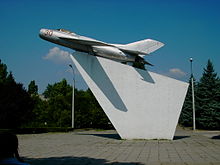
In 1941, before the occupation, the newspaper Dnestrovskaya Pravda was founded by the Tiraspol City Council of popular deputies. This is the oldest periodical publication in the region. On 12 April 1944, the city was retaken by the Red Army and became again part of the Moldavian SSR.
Post-secession
[edit]On 27 January 1990, the citizens in Tiraspol passed a referendum declaring the city as an independent territory.[citation needed] The nearby city of Bendery also declared its independence from Moldova. As the Russian-speaking independence movement gained momentum, some local governments banded together to resist pressure from the Moldovan government for nationalization.[citation needed]

On 2 September 1990, Tiraspol was proclaimed the capital of the new Pridnestrovian Moldavian Soviet Socialist Republic. The new republic was not officially recognized by Soviet authorities; however, it received support from some important Soviet leaders, such as Anatoly Lukyanov.[citation needed] After the dissolution of the Soviet Union, the territory east of the Dniester River declared independence as the Pridnestrovian Moldavian Republic (PMR), with Tiraspol as its capital. It was not recognized by the international community.[citation needed]

On 1 July 2005, the Lucian Blaga Lyceum, a high school with Romanian as its language of instruction, was registered as a Transnistrian non-governmental establishment. The registration of six Romanian language schools has been the subject of negotiations with the government since 2000.[citation needed] The tension increased in the summer of 2004, when the Transnistrian authorities forcibly closed the schools that taught using the Latin script. According to the official PMR view, this is considered as Romanian. "Moldovan", written in the Cyrillic script, is one of the three official languages in the PMR; Romanian is not. Some economic measures and counter-measures were taken on both banks of the Dniester.[citation needed]
Tensions have been seen in terrorist incidents. On 6 July 2006, an explosion, believed to be caused by a bomb, killed at least eight people in a minibus.[14] Later on 13 August, a grenade exploded in a trolleybus, killing two and injuring ten.[15][16][17]
On 25 April 2022, during the Russian invasion of Ukraine, several explosions were reported near the Ministry of State Security (Transnistria) in Tiraspol. Firefighters were on the scene but there were no casualties.[18]
On 17 March 2024, Transnistrian official press released a video allegedly[19] showing a Mil Mi-8 helicopter in poor condition and likely not in use,[20] not having been moved in over 13 years at the moment of the explosion,[19] in a military unit in Tiraspol being attacked and destroyed by a kamikaze drone. No victims were reported.[20] Transnistria claimed the drone had been launched from Ukraine from the direction of Odesa, more precisely from a bridge located 5–6 kilometres (3.1–3.7 miles) from the nearest border crossing between Transnistria and Ukraine. Ukraine immediately denied having anything to do with the incident.[19] On the day of the incident, the Bureau for Reintegration of the Republic of Moldova called it an "attempt to provoke panic and fear in the region".[20] Later, on 25 March, the bureau confirmed the explosion of the helicopter was not caused by a drone attack but by "other factors" and that the video contained "obvious elements of video montage". In the video, the drone disappears shortly before the explosion below the helicopter occurs. Reportedly, explosives placed under the helicopter were detonated remotely instead.[19]
On 8 January 2025, during the 2025 Moldovan energy crisis, a woman in Tiraspol died from carbon monoxide poisoning after using a gas water heater to shower without having a chimney.[21]
Geography and climate
[edit]Tiraspol features a humid continental climate that closely borders an oceanic climate and has transitional features of the humid subtropical climate due to its warm summers. Summers are mild, with average monthly temperatures at around 21 °C (70 °F) in July and August. Winters are cold, with average temperatures in the coldest month (January) at −2.7 °C (27 °F). Precipitation is relatively evenly spread throughout the year, though there is a noticeable increase in monthly precipitation in June and July. Tiraspol on average sees nearly 500 mm (20 in) of precipitation per year.
| Climate data for Tiraspol (1991–2020) | |||||||||||||
|---|---|---|---|---|---|---|---|---|---|---|---|---|---|
| Month | Jan | Feb | Mar | Apr | May | Jun | Jul | Aug | Sep | Oct | Nov | Dec | Year |
| Mean daily maximum °C (°F) | 1.8 (35.2) |
4.7 (40.5) |
10.6 (51.1) |
17.7 (63.9) |
23.6 (74.5) |
27.6 (81.7) |
30.3 (86.5) |
29.9 (85.8) |
23.8 (74.8) |
16.5 (61.7) |
9.2 (48.6) |
3.3 (37.9) |
16.6 (61.9) |
| Daily mean °C (°F) | −1.8 (28.8) |
−0.2 (31.6) |
4.5 (40.1) |
10.9 (51.6) |
16.7 (62.1) |
20.9 (69.6) |
23.2 (73.8) |
22.7 (72.9) |
17.0 (62.6) |
10.7 (51.3) |
4.9 (40.8) |
−0.1 (31.8) |
10.8 (51.4) |
| Mean daily minimum °C (°F) | −5.2 (22.6) |
−4.1 (24.6) |
−0.5 (31.1) |
4.6 (40.3) |
9.9 (49.8) |
14.4 (57.9) |
16.3 (61.3) |
15.7 (60.3) |
10.8 (51.4) |
5.6 (42.1) |
1.3 (34.3) |
−3.3 (26.1) |
5.5 (41.9) |
| Average precipitation mm (inches) | 35 (1.4) |
27 (1.1) |
30 (1.2) |
31 (1.2) |
47 (1.9) |
66 (2.6) |
57 (2.2) |
48 (1.9) |
49 (1.9) |
39 (1.5) |
38 (1.5) |
33 (1.3) |
500 (19.7) |
| Average precipitation days (≥ 1.0 mm) | 6 | 5 | 6 | 5 | 7 | 7 | 6 | 4 | 5 | 5 | 5 | 6 | 69 |
| Mean monthly sunshine hours | 60 | 88 | 146 | 206 | 281 | 301 | 324 | 306 | 215 | 153 | 73 | 52 | 2,224 |
| Source: NOAA[22] | |||||||||||||
Demographics
[edit]
Population
[edit]| Year | Pop. |
|---|---|
| 1870 | 16,692 |
| 1926 (est.) | 29,700 |
| 1939 | 43,676 |
| 2004 | 158,069 |
| Source: [23][24][25] | |
The population of the city was about 190,000 in 1989 and about 203,000 in 1992. 41% were Russians, 32% Ukrainians (both Eastern Slavic) and 18% were Moldovans (Romanians).[citation needed]
As result of the political and economic situation that followed the proclamation of the independent (unrecognized) Transnistria, as well as large Jewish emigration in the early 1990s, the population of the city fell below its 1989 number and the 2004 Transnistrian census put its population at 158,069.[25] In 1897, 31,616 people lived in the city of Tiraspol, who were classified, by language, in the following way:[26]
| Native language | Population | share of population |
|---|---|---|
| Russian | 14,013 | 44.32% |
| Yiddish | 8,568 | 27.1% |
| Ukrainian | 3,708 | 11.73% |
| Romanian | 3,611 | 11.42% |
| Polish | 1,003 | 3.17% |
| Belarusian | 119 | 0.38% |
| Bulgarian | 56 | 0.18% |
| Lithuanian | 7 | 0.02% |
| Latvian | 7 | 0.02% |
| Czech | 1 | 0.003% |
In 1926, 29,700 people lived in the city of Tiraspol who were classified, by ethnicity, as follows:
| Ethnic group | Population | % total share |
|---|---|---|
| Russian | 16,276 | 54.8% |
| Hebrew | 8,732 | 29.4% |
| Ukrainian | 4,277 | 14.4% |
| Moldovan (Romanians) | 416 | 1.4% |
According to the Soviet census of 1939, the city's population was 43,676 inhabitants, distributed as follows:[24]
| Ethnic group | Population | % Total share |
|---|---|---|
| Russian | 14,785 | 33.85% |
| Ukrainian | 12,504 | 28.63% |
| Hebrew | 11,764 | 26.93% |
| Moldovan (Romanian) | 3,480 | 7.97% |
- 2004[27]
| Ethnic group | Population | % Total share |
|---|---|---|
| Russian | 65,298 | 41.71% |
| Ukrainian | 52,278 | 33.07% |
| Moldovan (Romanian) | 23,790 | 15.05% |
| Bulgarian | 2,450 | 1.55% |
| Gagauz | 1,988 | 1.26% |
| Belarusian | 1,712 | 1.08% |
| German | 701 | 0.44% |
| Hebrew | 573 | 0.36% |
| Armenian | 360 | 0.23% |
| Polish | 324 | 0.2% |
| Gypsy/Rromi/Romani | 116 | 0.07% |
| Others | 7,849 | 4.98% |
Religion
[edit]The Latin Catholic minority is served by the Roman Catholic Diocese of Chișinău.
In the fourteenth century, Tiraspol was the see city of the diocese of Kherson; in 1848, a Roman Catholic Diocese of Tiraspol was erected with its see in Saratov. Since 1993, it did not cover any Moldovan territory, not even Tiraspol. The diocese was suppressed in 2002.
Culture
[edit]

The statue of Alexander Suvorov was erected in the central square in 1979 in commemoration of his 250th anniversary. In front of the Transnistrian Government building there is a statue of Vladimir Lenin. On the opposite side of the central square, a monument plaza features a Soviet T-34 tank, commemorating the Soviet victory in World War II, an eternal flame to those who fell defending the city in 1941 and liberating it in 1944, as well as several monuments dedicated to more recent conflicts, including the Soviet–Afghan War and the War of Transnistria.
Sport
[edit]
The two main football clubs are Sheriff Tiraspol and FC Tiraspol. Sheriff is the most successful Moldovan football club of recent history, winning 14 league titles since the 2000–2001 season, and 6 Moldovan Cups. The team gained world notoriety for their last-minute 2–1 victory during the 2021–22 UEFA Champions League edition against later tournament winners Real Madrid on 28 September 2021. A third club, CS Tiligul-Tiras Tiraspol, withdrew from competition prior to the 2009–2010 season. Tiraspol is home to the Sheriff Stadium, the largest capacity stadium in the region, with a capacity of 14,300 seats.
International relations
[edit]Twin towns – sister cities
[edit] Bălți, Moldova[28]
Bălți, Moldova[28] Comrat, Moldova[28]
Comrat, Moldova[28] Trondheim, Norway (2000)[29][30]
Trondheim, Norway (2000)[29][30] Volgograd, Russia[31]
Volgograd, Russia[31] Kaluga, Russia[31]
Kaluga, Russia[31] Kursk, Russia[31]
Kursk, Russia[31] Obninsk, Russia[31]
Obninsk, Russia[31] Severodvinsk, Russia[31]
Severodvinsk, Russia[31] Novosibirsk, Russia[31]
Novosibirsk, Russia[31] Mykolaiv, Ukraine[32]
Mykolaiv, Ukraine[32] Kherson, Ukraine[32]
Kherson, Ukraine[32] Cherkasy, Ukraine[32]
Cherkasy, Ukraine[32] Ternopil, Ukraine[32]
Ternopil, Ukraine[32] Ashdod, Israel[33]
Ashdod, Israel[33] Leninsky District, Minsk, Belarus[34]
Leninsky District, Minsk, Belarus[34] Sokhumi, Abkhazia[35]
Sokhumi, Abkhazia[35] Tskhinvali, South Ossetia[36]
Tskhinvali, South Ossetia[36] Santarem, Portugal[37]
Santarem, Portugal[37]
Notable people
[edit]

- Yuri Avvakumov (born 1957), Russian architect, artist, and curator
- Nikolay Zelinsky (1861–1953), Russian and Soviet chemist who invented the first filtering activated charcoal gas mask
- Georgi Stamatov (1869–1942), Bulgarian writer
- Mikhail Larionov (1881–1964), Russian avant-garde painter
- Abraham Rabinovitch (1889–1964), Australian-Russian property developer and pioneer of the Sydney Modern Orthodox Jewish community
- Gheorghe Pintilie (1902–1985), Soviet intelligence agent, Russian citizen and naturalised Romanian communist activist of Ukrainian origin, the first Director of the Securitate
- Izrail Shmurun (1912–1985), Moldavian Soviet architect
- Larisa Eryomina (born 1950), stage and screen actress
- Oxana Ionova (born 1966), head of the state tax service of Transnistria, director of Transnistria's central bank from 2008 to 2011; subsequently charged with embezzlement of Russian humanitarian aid, illegal business practices, abuse of power and forgery
- Vlad Stashevsky (born 1974), Russian pop singer
- Berenika Glixman (born 1984), Israeli classical pianist
- Sergey Stepanov (born 1984), musician and composer, member of the SunStroke Project
- Valeria Lukyanova (born 1985), Ukrainian model, famous for her resemblance to a Barbie doll, lives in Moscow
Politics
[edit]- Serhii Kivalov (born 1954), Ukrainian politician, jurist, parliamentarian, head of Central Election Commission
- Vladimir Mikhailovich Belyaev (born 1965), the minister of information and telecommunications
- Maya Parnas (born 1974), politician and was the former acting Prime Minister of Transnistria
- Nina Shtanski (born 1977), former Transnistrian state politician, the Minister of Foreign Affairs 2012 to 2015
- Roman Khudyakov (born 1977), Russian politician, chairman of the Liberal Democratic Party of Transnistria
- Vladimir Yastrebchak (born 1979), the Minister of Foreign Affairs of Transnistria from 2008 to 2012.
- Olga Paterova (born in 1984), politician, the press secretary for the political youth organization Breakthrough
- Yury Cheban, Transnistrian Minister of Natural Resources and Ecological Control
Sport
[edit]- Constantin Nour (1906 or 1907 – 1986), Romanian champion middleweight boxer and national team trainer
- Larisa Popova (born 1957), rower who competed for the Soviet Union in the 1976 Summer Olympics
- Igor Samoilenco (born 1977), boxer
- Andrei Mihailov (born 1980), backstroke swimmer, competed in the 2000 and the 2004 Summer Olympics
- Andrei Corneencov (born 1982), Moldovan international footballer.
- Stanislau Tsivonchyk (born 1985), Belarusian pole vaulter, competed in the pole vault at the 2012 Summer Olympics
- Vitalie Bulat (born 1987), footballer
- Oleksandr Kolchenko (born 1988), Ukrainian basketball player
- Dănilă Artiomov (born 1994), breaststroke swimmer
- Artur Dalaloyan (born 1996), Russian artistic gymnast of Armenian origin
Gallery
[edit]-
Sign at the entrance to Tiraspol
-
A street in central Tiraspol
-
The Victory Park
-
The Dnestr river passing through Tiraspol
-
The statue of Lenin in front of the parliament building
-
Street scene
-
Railway station
-
Trade union building and fire station
-
War memorial and the Tomb of the Unknown Soldier
-
Part of the city centre
-
Photo of the Suvorov Square in Tiraspol
-
Photo of the Suvorov Monument in Tiraspol
Notes
[edit]- ^ Transnistria's political status is disputed. It considers itself to be an independent state, but this is not recognised by any UN member state. The Moldovan government and the international community consider Transnistria a part of Moldova's territory.
References
[edit]- ^ "Citypopulation.de_Tiraspol". citypopulation.de.
- ^ a b Cucerescu & Rosca 2015, p. 188.
- ^ "Министерство иностранных дел ПМР". Министерство иностранных дел.
- ^ Rotaru, Florin (1996), Românitatea Transnistriană (PDF), p. 212, archived (PDF) from the original on 16 October 2021
- ^ Frunza, A (1915), România Mare (PDF), p. 63, archived (PDF) from the original on 9 September 2022
- ^ "About Transdniestra (Russian)". Archived from the original on 15 April 2008. Retrieved 27 December 2006.
- ^ Cooper, Jason (14 October 2006). "Street Fairs, Celebrations Mark Tiraspol's 214th Birthday". Tiraspol Times & Weekly Review. Archived from the original on 30 September 2007. Retrieved 20 February 2007.
- ^ Tsoni, Paula (5 June 2022). "How Transnistria's Tiraspol Got Its Ancient Greek Name". Greek Reporter. Retrieved 15 April 2023.
- ^ See E. H. Minns, Scythians and Greeks (Cambridge, 1909); V. V. Latyshev, Inscriptiones Orae Septentrionalis Ponti Euxini, vol. I.
- ^ Cucerescu & Rosca 2015, p. 187.
- ^ Baranchikov, E. V. (2017). "ТИРАСПОЛЬ". old.bigenc.ru. Retrieved 22 January 2024.
- ^ a b c Cucerescu & Rosca 2015, p. 189.
- ^ "Tiraspol | Moldova | Britannica". www.britannica.com. Retrieved 15 April 2023.
- ^ "Trans-Dniester Blast Kills Eight". BBC News. 6 July 2006.
- ^ "Trolley Bus Blasted in Tiraspol Possibly in a Terror Attack". Regnum. Archived from the original on 30 September 2007.
- ^ "New Bus Explosion in Tiraspol Leaves One Dead, Eleven Injured". Tiraspol Times & Weekly Review. 14 August 2006. Archived from the original on 30 September 2007.
- ^ "Another Blast in Public Transport in Tiraspol". Moldpres News Agency. 17 August 2006. Archived from the original on 28 September 2007.
- ^ "Moldovan president holds security meeting after blasts in Transnistria". The Jerusalem Post | Jpost.com.
- ^ a b c d Pop, Radu (26 March 2024). "Tiraspolul înscenează explozii ca să înfricoșeze populația". Știri pe surse (in Romanian).
- ^ a b c "VIDEO Momentul atacului reclamat de Transnistria: O dronă lovește un elicopter scos din uz și care era parcat pe platformă". HotNews (in Romanian). 17 March 2024.
- ^ "Четверо бендерчан и тираспольчанка отравились угарным газом от колонок". Novosti Pridnestrovya (in Russian). 8 January 2025.
- ^ "Tiraspol Climate Normals 1991–2020". World Meteorological Organization Climatological Standard Normals (1991–2020). National Oceanic and Atmospheric Administration. Archived from the original on 21 August 2023. Retrieved 21 August 2023.
- ^ Słownik geograficzny Królestwa Polskiego i innych krajów słowiańskich, Tom XII (in Polish). Warszawa. 1892. p. 718.
{{cite book}}: CS1 maint: location missing publisher (link) - ^ a b "Демоскоп Weekly - Приложение. Всесоюзная перепись населения 1939 года". www.demoscope.ru.
- ^ a b "2004 Census: PMR Urban, Multilingual, Multicultural". Pridnestrovie.net. Archived from the original on 26 July 2010.
- ^ "1897 Counties and Cities". pop-stat.mashke.org (in Russian).
- ^ The Transnistrian census of 2004 data by nationality at http://pop-stat.mashke.org/pmr-ethnic-loc2004.htm
- ^ a b "Молдова | Официальный сайт Государственной администрации г.Тирасполя и г.Днестровска". tirasadmin.org. Retrieved 6 August 2021.
- ^ "Trondheims vennskapsbyer". trondheim.no (in Norwegian). Archived from the original on 18 May 2015.
- ^ "Норвегия | Официальный сайт Государственной администрации г.Тирасполя и г.Днестровска". tirasadmin.org. Retrieved 6 August 2021.
- ^ a b c d e f "Города-побратимы – РФ | Официальный сайт Государственной администрации г.Тирасполя и г.Днестровска". tirasadmin.org. Retrieved 6 August 2021.
- ^ a b c d "Города-побратимы – Украина | Официальный сайт Государственной администрации г.Тирасполя и г.Днестровска". tirasadmin.org. Retrieved 6 August 2021.
- ^ "Израиль | Официальный сайт Государственной администрации г.Тирасполя и г.Днестровска". tirasadmin.org. Retrieved 6 August 2021.
- ^ "Города-побратимы-Республика Беларусь | Официальный сайт Государственной администрации г.Тирасполя и г.Днестровска". tirasadmin.org. Retrieved 6 August 2021.
- ^ "Абхазия – Сухум | Официальный сайт Государственной администрации г.Тирасполя и г.Днестровска". www.tirasadmin.org. Retrieved 6 August 2021.
- ^ "Южная Осетия | Официальный сайт Государственной администрации г.Тирасполя и г.Днестровска". tirasadmin.org. Retrieved 6 August 2021.
- ^ "Португалия – Сантарен | Официальный сайт Государственной администрации г.Тирасполя и г.Днестровска". tirasadmin.org. Retrieved 6 August 2021.
Further reading
[edit]- Tiraspol (p. 422) at Miriam Weiner's Routes to Roots Foundation
- Cucerescu, Vasile; Rosca, Simon (2015). "Tiraspol – the border city of Eastern Latinity". Eurolimes. No. 19.
External links
[edit]Non-Transnistrian links
[edit]- Tiraspol, Moldova at JewishGen
- Tyraspol (Tiraspol) in the Geographical Dictionary of the Kingdom of Poland (1892)(in Polish)
Transnistrian links
[edit]- Tiraspol.info (in Russian)










